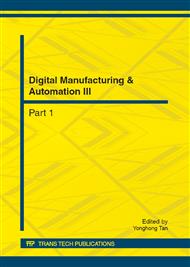[1]
J. Larminie and A. Dicks, Fuel Cell Systems Explained 2nd ed., JohnWiley & Sons Ltd, England, pp.200-226, (2003).
Google Scholar
[2]
E.S. Hecht, G.K. Gupta, H. Zhu, A.M. Dean, R.J. Kee, L. Maier, O. Deutschmann: Methane reforming kinetics within a Ni-YSZ SOFC anode support, Applied Catalysis A: General 295, pp.40-51 (2005).
DOI: 10.1016/j.apcata.2005.08.003
Google Scholar
[3]
V. M. Janardhanan, O. Deutschmann: CFD analysis of a solid oxide fuel cell with internal reforming: Coupled interactions of transport, heterogeneous catalysis and electrochemical processes, Journal of Power Sources 162, pp.1192-1202 (2006).
DOI: 10.1016/j.jpowsour.2006.08.017
Google Scholar
[4]
P. Hofmann, K.D. Panopoulos, L.E. Fryda, E. Kakaras: Comparison between two methane reforming models applied to a quasi-two-dimensional planar solid oxide fuel cell model, Energy 34, pp.2151-2157 (2009).
DOI: 10.1016/j.energy.2008.09.015
Google Scholar
[5]
C. Li, Y. Shi, N. Cai: Elementary reaction kinetic model of an anode-supported solid oxide fuel cell fueled with syngas, Journal of Power Sources 195, pp.2266-2282 (2010).
DOI: 10.1016/j.jpowsour.2009.10.051
Google Scholar
[6]
V. Yurkiv, A. Utz, A. Weber, E. Ivers-Tiffee, H. Volpp, W.G. Bessler: Elementary kinetic modeling and experimental validation of electrochemical CO oxidation on Ni/YSZ pattern anodes, Electrochimica Acta 59, pp.573-580 (2012).
DOI: 10.1016/j.electacta.2011.11.020
Google Scholar
[7]
J.V. Rickenbach, M. Nabavi, I. Zinovik, N. Hotz, D. Poulikakos: A detailed surface reaction model for syngas production from butane over Rhodium catalyst, International journal of hydrogen energy 36, pp.11238-12248 (2011).
DOI: 10.1016/j.ijhydene.2011.06.127
Google Scholar
[8]
B. Sundén and J. Yuan: Development of Multi-scale Models for Transport Processes Involving Catalytic Reactions in SOFCs, Int. J. Micro-Nano Scale Transport, Vol. 1, No. 1, pp.37-42 (2010).
DOI: 10.1260/1759-3093.1.1.37
Google Scholar
[9]
BA Haberman, JB Young: Three-dimensional Simulation of Chemically Rreacting Gas Flows in the Porous Support Structure of an Integrated-planar Solid Oxide Fuel Cell, Int.J. Heat Mass Tranfer, 47, pp.3617-3629 (2004).
DOI: 10.1016/j.ijheatmasstransfer.2004.04.010
Google Scholar
[10]
I.L. Mostinsky: Diffusion cofficient in: International Encyclopedia of Heat & Mass Transfer, G.F. Hewitt, G.L. Shires, and Y.V. Polezhaev (eds. ), 1996, CRC Press, Florida, USA.
Google Scholar
[11]
A. Aguiar, C.S. Adjiman, and N.P. Brandon: Anode-supported Intermediate Temperature Direct Internal Reforming Solid Fuel Cell, I: Model-based Steady-state Performance. J. Power Sources 138, pp.120-136 (2004).
DOI: 10.1016/j.jpowsour.2004.06.040
Google Scholar
[12]
H. Yakabe, M. Hishinuma, M. Uratani, Y. Matsuzaki and J. Yasuda: Evaluation and Modeling of Performance of Anode-supported Solid Oxide Fuel Cell, J. Power sources 86, pp.423-431 (2000).
DOI: 10.1016/s0378-7753(99)00444-9
Google Scholar
[13]
J. Yuan and B. Sunden: Analysis of Chemically Reacting Transport Phenomena in an Anode Duct of Intermediate Temperature SOFCs, ASME J. Fuel Cell Sci., Tech. and Engn., 2, pp.89-98, (2006).
DOI: 10.1115/1.2173662
Google Scholar
[14]
R.J. Kee, M.E. Coltrin, P. Blarborg: Chemically Reacting Flow, John Wiley & Sons. Inc., Hoboken, NJ, (2003).
Google Scholar
[15]
J. Yuan, Y. Huang, B. Sundén and W.G. Wang: CFD Approach to Analyze Parameter Effects on Chemical-Reacting Transport Phenomena in SOFC Anodes, Heat and Mass Transfer, 45, pp.471-484 (2009).
DOI: 10.1007/s00231-008-0449-6
Google Scholar


